https://www.youtube.com/watch?v=NkfY31vrMe8
Attempting to Solve a Square-2 (With NO Help)

This is the square one and this is the square 23 years ago was the first time that I solved a square one .
OK .
It was also the only time I solved a square one .
So I don't remember how I did that .
This video kicked off a series where I tried to solve many different puzzles .
Some of them were easier than expected and others really pushed me to my limit .
So three years later , we've come full square and I'm going to solve the square two with no memory of how I solved the square 11 of the difficulties with square one is when you get it out of cube shape , you can run into situations where it doesn't turn because we normally turn along this line .
But this piece does not split in half .
The only difference on a square two is that the corner pieces are cut in half .
So you can make these turns .
In fact , it's kind of like a pizza where every single piece is the same size .
So you can always turn absolutely anywhere .
And the only other thing you have to know about both square one and square two .
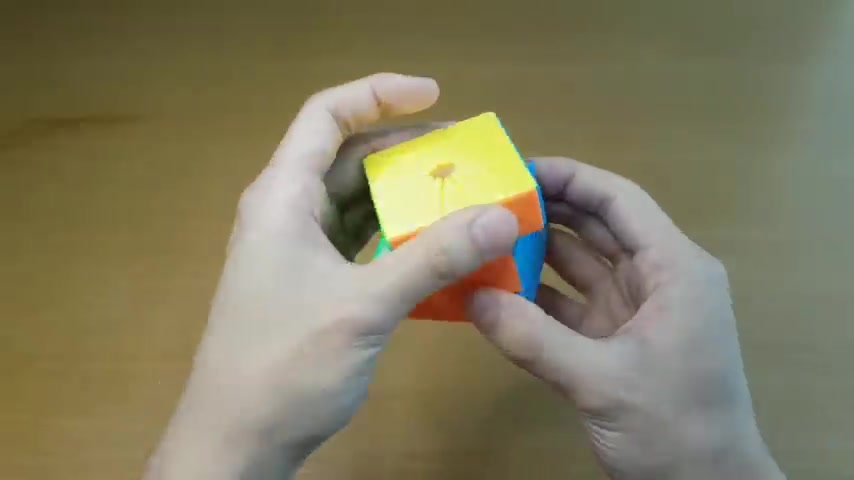
Is , they can only turn the bottom the top and they can do what's called the slice move , which turns this side 180 degrees .
And then you can turn top and bottom again and turn this again .
And let's start scrambling it .
Oh , no .
Yeah , this gets looking way crazier than the square one because the corner pieces are in half .
So they make this really jagged looking shape .
And I'm really curious if this is going to be easier or harder than a square one .
Like obviously , there are more pieces which makes it harder .
But you can always turn .
There's no what you call bandaging where the cube has spots where it's unable to turn .
So this one will always be able to turn , but there are more pieces to solve and I'm interested to see if that makes it easier or harder .
OK ?
This looks pretty scrambled .
I'm gonna start as always by just trying to do something .
Let's see .
I just want to get a feel for my freedom on this cube .
It's not really a cube , but I'm gonna try and get these two that are solved .
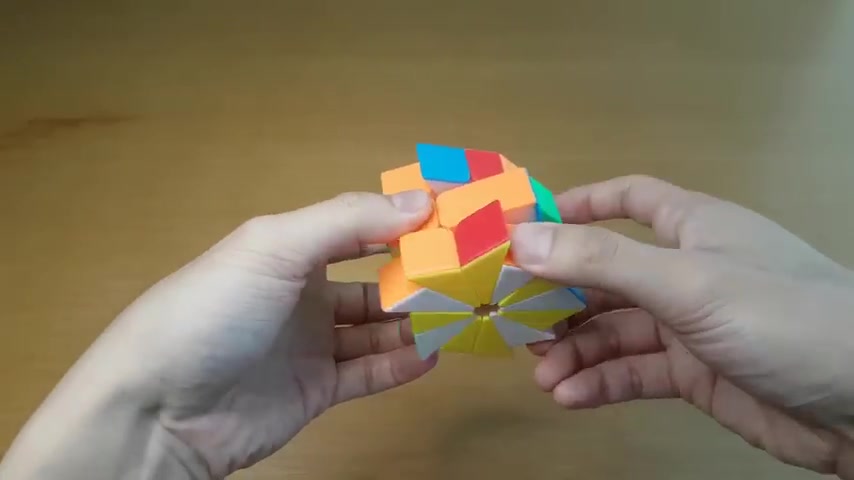
I'm gonna try and attach this one here and just see if I can do that .
So I think if I move it to the other side , get it like here , maybe move it up .
Oh Hey , that was pretty easy .
I don't know if I need to do this , but my goal is kind of to turn the top and bottom into squares to make this into a cube shape .
So where's the other white blue piece ?
No , it's not white blue that goes here .
Uh Next to blue should be , I think it should be orange .
So that would be one of these two pieces .
Uh If they put together like this and this one is the one that goes there .
OK .
The slice happens here so I can move this one over to the edge of the slice , slice it up .
Oh That's the , that's the wrong one .
I like how I reasoned exactly which one it should be and then it was wrong .
There we go .
It looks really easy right now .
But I guarantee you my progress is going to be stopped at some point .
So here's the white orange and here's where it goes .
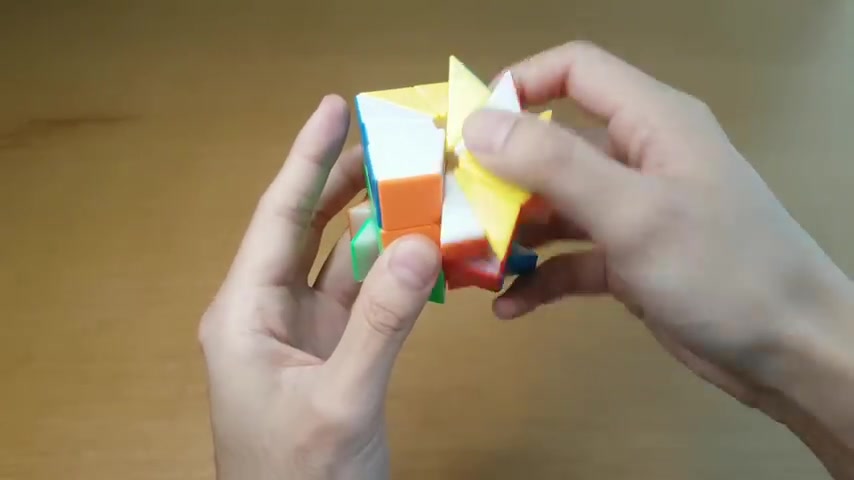
So I think I can just move this one away and then get the spot here and move it back up .
OK ?
There we go .
OK ?
I have half of the square up here .
You can see that turning in half is means solving half wouldn't be that hard , but solving the other half , that would be the hard part .
OK ?
So I got my next piece here .
Now we have our first issue where if I want to put the next one , which is white green , which is this one , then once I move it up like that's , that's good .
But it's going to kick out this one that I've solved at the back .
Ok .
Normally on a three by three , I would say that's easy .
Just take this part and move it to the side .
But that , that's , you can't do moves like that .
There's only one possible move you can do to switch things between the top and the bottom .
And uh other than that , you can only turn the top and the bottom .
So I'm pretty restricted here on what I can do .
OK .
Different plan .
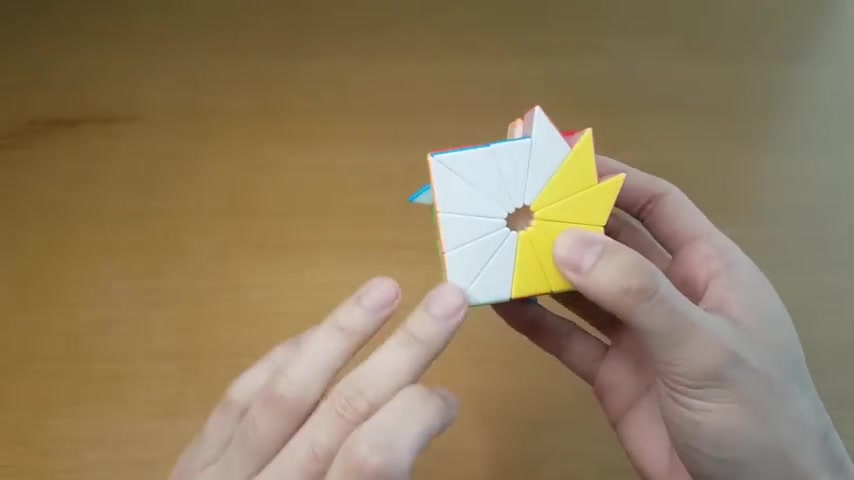
What if I just tried to make this as cube Shapey as possible like that ?
That looks like a lot of it's done .
But then we got this side .
OK .
OK .
New plan , new plan .
I'm gonna turn this whole thing upside down and I'm just gonna say that this white uh part that I've solved here is just salt and I'm going to , then if I only turn this side , I'll never disturb it again .
And I can just do the same thing for a half square on yellow .
I'm not not seeing a way to make cube shape right now , which is worrying me .
But um I can still try to um make just as much as I can and see where that takes me because when you're approaching a new puzzle , knowing the right answer of what to do is not always easy to figure out .
OK , I want this one here and um I'm just realizing that this isn't too hard for me because I already know how to do three by three .
So a lot of my intuition still sort of works .
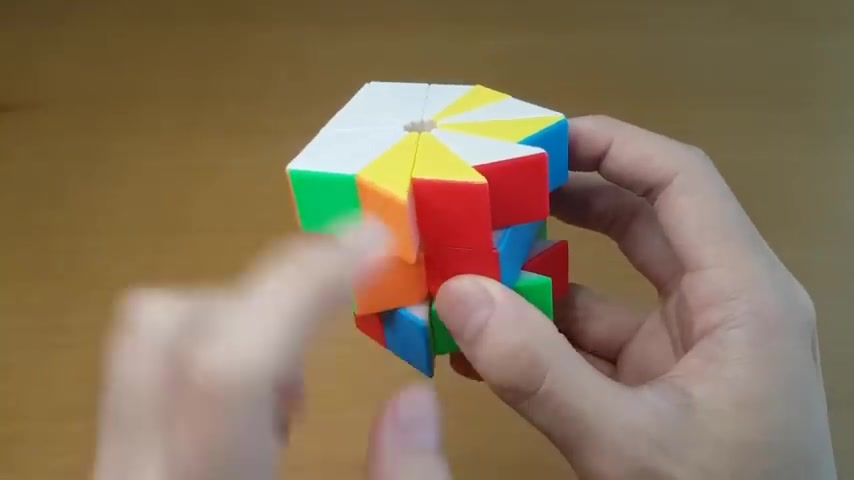
And uh if you are actually approaching this with no puzzle knowledge at all , this would be so much harder .
I'm trying to get this yellow red right here , which is a bit of a problem because how I was doing it before was I would just move it next to the slice area on this side and then I could just move it up , right .
But the problem here is I'm also trying to preserve this .
So I cannot actually move the bottom layer at all .
And that means I need to move it up , do this and then move it back down .
So it's next to the slice layer and then I can move it up .
OK ?
That is not too much of a problem .
I can , I can deal with that next to red should be uh blue .
So we're gonna get one of the blue corners .
I think it's this one .
So I'm gonna take this .
Well , I can't just move it straight down like that because that's breaking stuff I'm making .
Wow , this is getting really restrictive , but I can try to preserve the stuff I'm making .
Just keep doing this over and over until it's at the bottom .
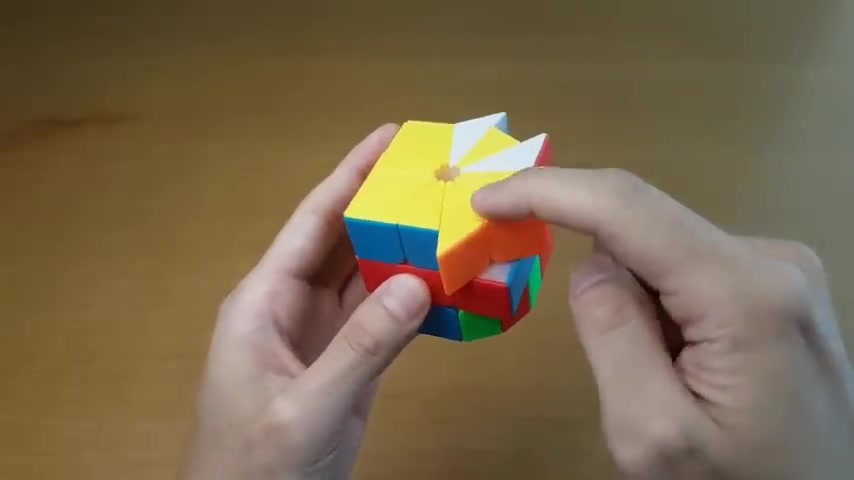
Perfect .
There we go .
OK .
Now I need the yellow blue here .
Can I it's right here .
123 .
Now it's right here .
123 .
Now it's right here .
It is slowly creeping over .
I hope you can see how I'm doing this .
But that's so funny .
I'm doing so many moves just to move this one over .
OK .
There we go .
And now I need the yellow blue here , yellow blue here .
But I don't think there's a way I can do that because now if I slice , I need to preserve everything in this side .
So I can't turn the bottom layer and I need to preserve everything on this side .
So I can't turn the top layer .
If I do try to do what I just did to slowly creep it over this yellow blue , then I'm going to need to do this turn first and that's gonna break up this green that I have .
So uh well , we'll do it anyway .
We'll see what happens .
Yeah , that just moves the yellow green slowly away .
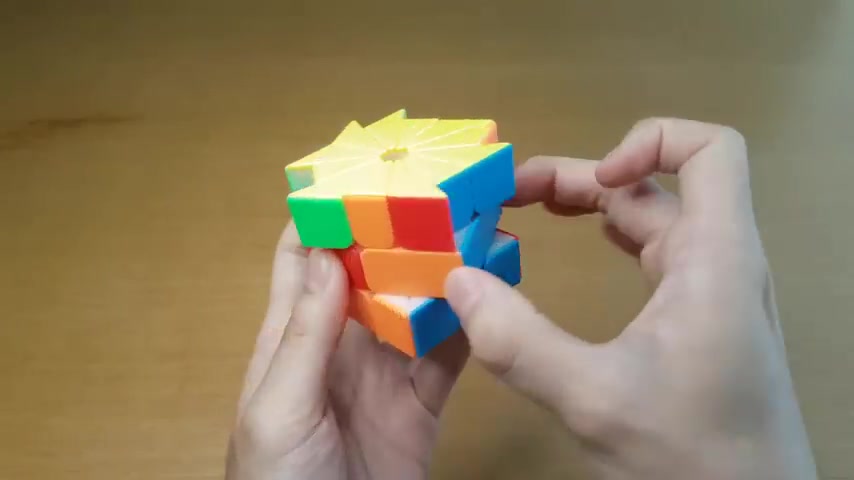
So really , I'm just taking yellow blue , moving it closer and taking yellow green and moving it further .
OK .
Honestly , I guess this is not the way to solve it , but I do feel like I've learned a lot from this and that's why you kind of want to approach it with uh anything that you can think of .
OK .
I had this marvelous idea to just solve this white part instead and move it down .
And now I have , I have this square made and oh , I do know how to flip the center parts which is just uh wait a minute , orange matching red .
What that means is the color scheme is wrong .
Now , I'm pretty sure the color scheme is right .
I just need to put white on the opposite side like that .
And then what ?
Oh no , no , no , no , no .
This part needs to flip and how you can do that is just repeat our twos and U two si think uh like that .
OK .
OK .
OK .
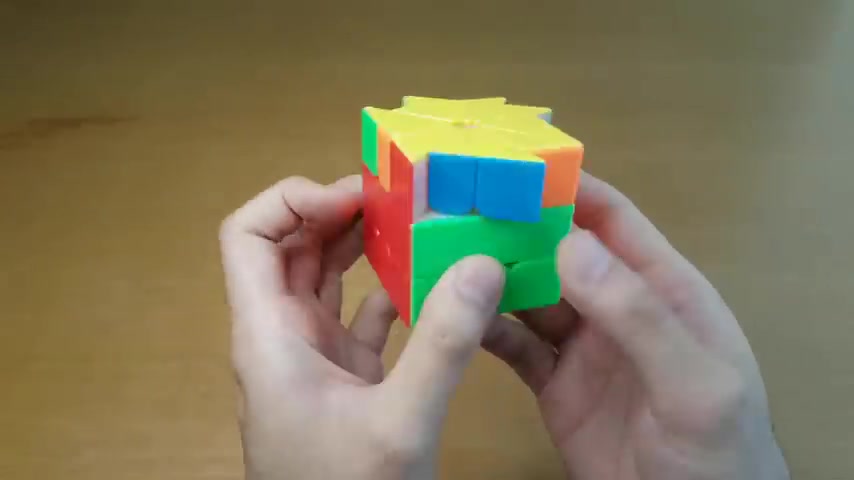
So it looks like I've solved F two L and OLL .
So all I have left is one PLL algorithm .
OK .
Look , I have no clue what to do from here , but it does look like I've made a lot of progress even though I don't think this is ultimately the way we're going to solve it , what would I even call this PLL ?
It needs to move around a lot of pieces .
So I think I would call this a G term .
OK .
I'm thinking back to square one and I roughly remember how I approached this next step .
I broke up the first layer and then fixed it and then that just did something to the top .
I don't know what .
And that it allowed me to use that thing that I discovered as an algorithm .
I'm not cheating .
That's not square one knowledge .
That is just general puzzle solving knowledge .
OK ?
I think that I remember the way I broke it up on square one was kind of like obviously I had to save the , the corner duos because those were just one piece .
I don't have to do that on this one though .
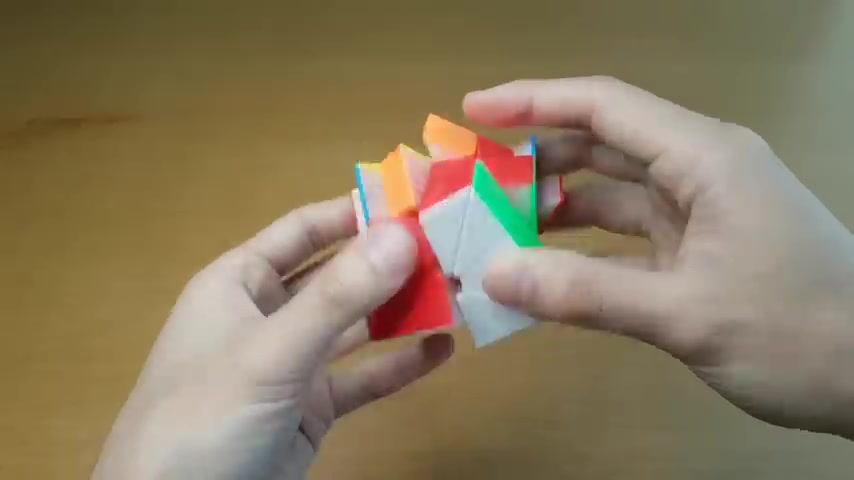
So I can probably come up with something else and I should because I shouldn't try to do the same thing as what I did .
Let's see if I take out this edge .
How would I recombine it back into the bottom like this , like this like this ?
And then I would combine these and then move it all back down .
That was so that was not , that doesn't even work .
Wait , this color scheme is wrong .
That's why orange doesn't even go there .
Please tell me this will work putting it back together .
OK ?
Looks like something in the top layer changed .
But I don't know what because that was so long .
Should I play back the video and see what I did and see what it did to the top layer ?
Because I'm sure that did something to the top layer .
But that algorithm might have done so much that the algorithm wouldn't even be usable .
OK .
Well , what if I move it up and take like two pieces out of the edge and the corner ?
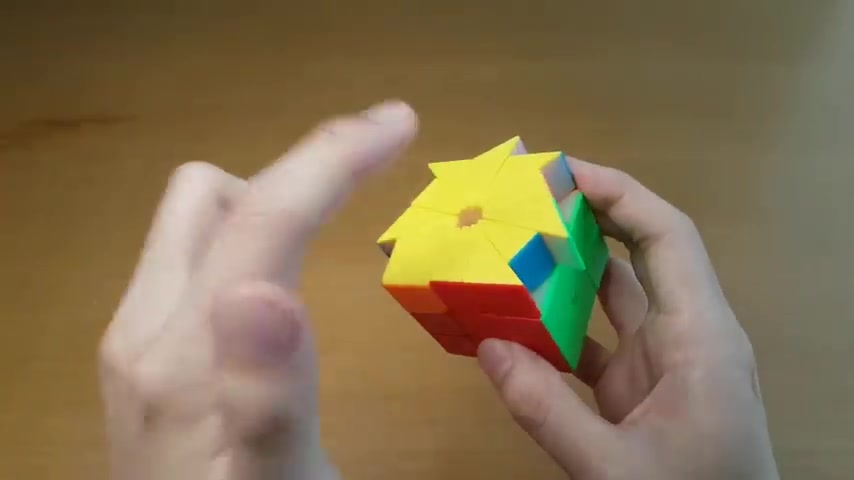
Maybe I'll have a bit more freedom to move here guys , I just discovered something .
Oh , this was completely by accident , but I think I could maybe solve everything with what I just discovered .
OK .
Let me walk you through my thought process there because oh , this could be huge .
So what I was originally thinking was the white layer is solved and the yellow layer is not .
So I need to make an algorithm by just doing random stuff in a way that keeps the white layer solved .
At the end of that , that is not necessary .
I was trying some stuff and I realized , OK , if I take all this out , do one turn and move it all back down , then this actually destroys half of the white layer .
This part is still together , but none of these pieces are solved because they all need to be shifted over by one .

But then I realized , hey , what if I just moved all this shifted back like just , you know , undo the moves I just did except obviously not just undo them because then I would do nothing but maybe do something to the top layer first like this , then move it all back down .
And you can see like OK , the white layer is not solved .
There is one piece in here and the other white one is up here .
But then I realized when you can change only one thing in one layer , then you can do this special technique .
Let's see if you guys can guess what I'm about to do .
I've never done this before .
It's called commutators .
And I'm pretty confident because I can do U and D moves and because I can swap one piece into the other layer , then I can do mus and I can actually solve the rest of this .
I am that confident in it and let me show you why .
So if you've never seen a commentator before , let me explain to you how they work .
Commentators are a way you can cycle three pieces and I'm going to do something .

Let me just do 123 and you don't have to worry about exactly what that did .
But what you do have to see is that the bottom layer , everything in it is the same as before except for one piece .
And then we're going to turn the bottom layer and undo those first three moves and then move the bottom layer back to solved .
And now you can see that three pieces only have moved one way that you can think about how commentators work is this one , I'm moving into its solved spot .
Ignore the top two layers .
This is solved .
And if we look at what was there before it was the other yellow piece that goes here .
So I move this one into the solve spot , I get the other one solved spot over and then I undo the first three moves .
So this one will come back to where it was bottom , right ?
When I do the first three moves , why doesn't this messing up the cube really have any effect later ?
Why does it all just come back to solved ?
Well , that's because I'm just going to undo it later .
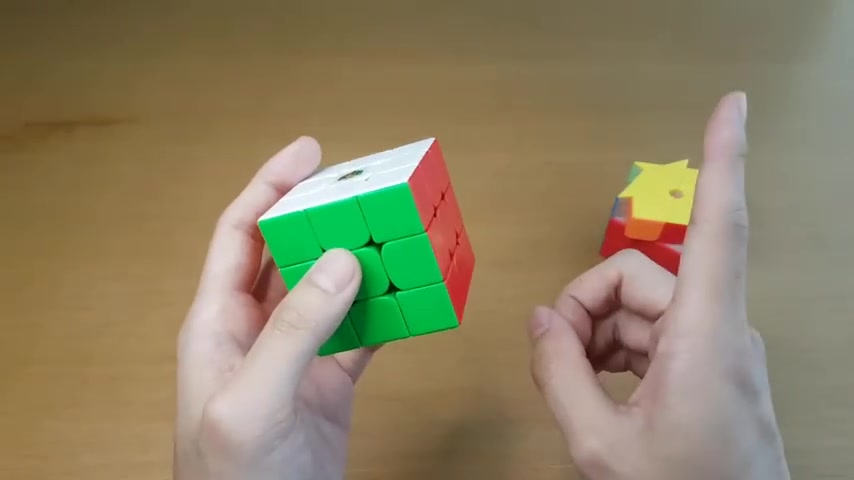
The only thing I'm not undoing is the fact that this one in the bottom layer switched to something else , which is why only one piece in the top ends up being wrong .
OK .
That's as much as I'm going to explain , you can watch the commentator tutorial if you really , really want to know how this works .
But that is what I'm gonna try and do for the rest of this solve .
OK .
So before we start here , I'm just gonna do that algorithm once to take something out of the white side and you'll see why I'm doing this in a second .
But here now the white side is unsolved .
So now I can start thinking about this like a commentator .
So let me uh let me show you what I mean .
I'm gonna try and solve this yellow blue and uh where should I solve it ?
Well , this is a yellow blue .
So that means this yellow blue needs to go to this spot right here so that they make their face .
OK ?
And then this one is going to go to this spot .
But then I need to figure out where this one goes .
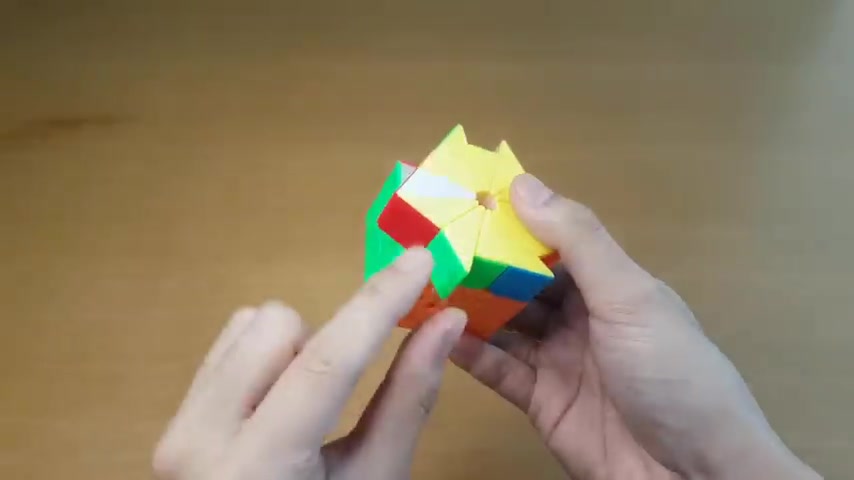
Uh because this one is going to replace this and this will go to the top , then I need to turn the D layer in some way that when the yellow green comes back down , it's going to go into its correct spot .
And OK , if this side is blue and this side is red .
That means this yellow green goes to this spot right here .
OK .
How many spots over is that , that is 1234 ?
OK .
So I'll have to do like ad four at some point .
All right .
So this one goes to the left side of the slice and the spot that I want it to go to will be on the right side of the slice here .
And I'll just do the algorithm and this one should go down to here .
So uh R two ur two U prime R two U prime R two .
OK .
Now you can see that this is solved and then I'll do 1234 at the bottom and then I'll undo that and the yellow green will go back down to its correct spot .
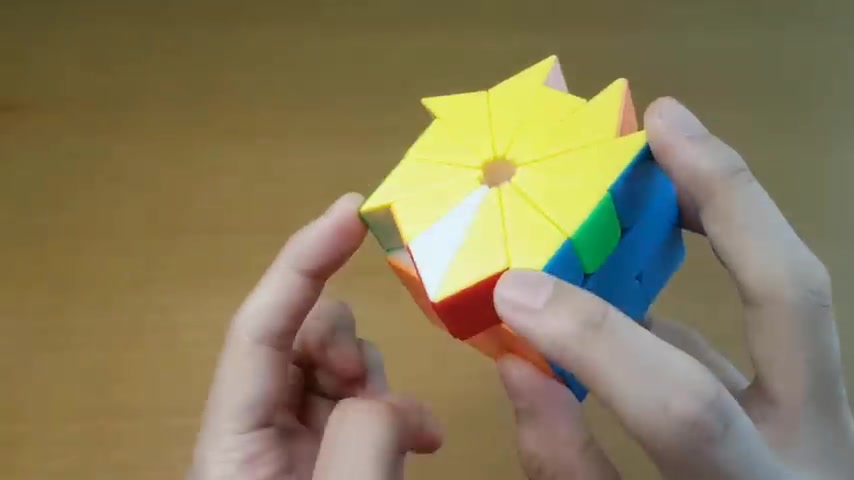
So R two ur two ur two U prime R two .
OK ?
Let's align everything .
Look at that .
These are all solved now and every piece is the same edge pieces , corner pieces , they're all the same on a square two .
So I think I could actually solve the rest with just this .
I mean it works for this .
It should work for everything .
Now , before some of you guys say I cheat .
This is not even square two knowledge .
I'm allowed to use any knowledge from any puzzle that is always allowed because this is my brain not pretending to be a beginner .
So what I'm thinking next is this yellow green , put it to the left of the slice needs to go to this spot .
Um And this is on the right of the slice now .
So that way these two will both be green .
And then where does this yellow red need to go ?
That one needs to go right here because the it goes blue and then red .
I think that order .
No , no , no , no , no , no , no , it goes here .
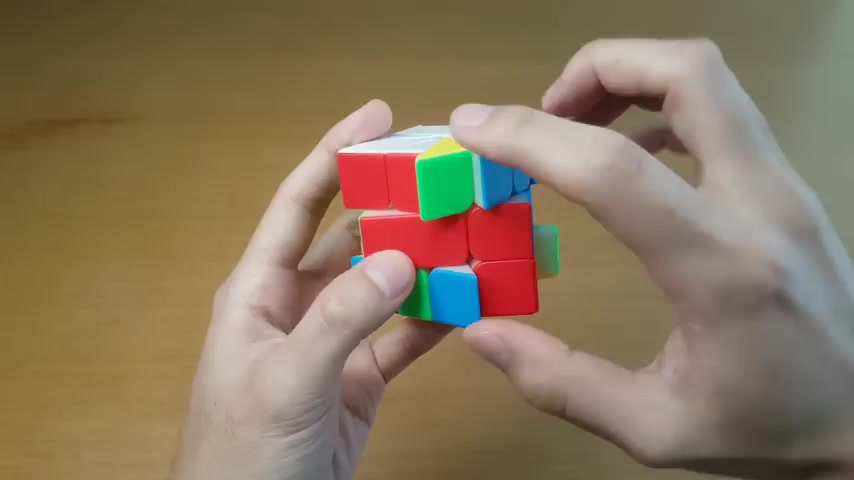
I think the color scheme and everything is messing me up .
OK ?
Basically , it needs to move one spot to this side .
So I'm just gonna move it one over later .
But we're gonna take the green , move it to where it belongs .
Uh 123 like that and then move the bottom over by one .
And then now the yellow red will go back down to its spot .
Reverse the algorithm .
Look at that .
Look , we are getting places .
This is almost done .
All I have to do is not mess up .
All I have to do is not mess up easy , right ?
This orange one , this corner needs to go here I think .
And then this edge needs to go here .
Move this one to the left , this one's on the right good .
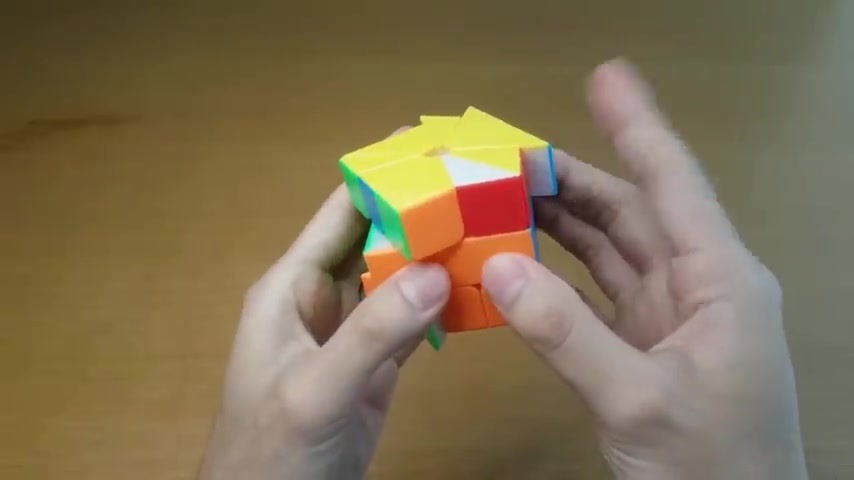
Do the algorithm uh with that , move this 11 over so that the orange edge can come back to the spot and reverse the algorithm .
There we go .
There we go , they're solved .
OK ?
We are almost there , we have uh a few pieces left .
So since uh we have a solved white layer , we can't actually solve the very next piece that we attempt , but we can solve the piece after that .
So let me show you what I mean .
Um Next , we're gonna take the uh we're gonna take a white piece .
So this one , any white piece is fine and we're gonna move it to this , this spot with the blue .
We actually do need the green piece here , not um a white piece , but we don't have a choice .
We're just going to put the white piece here and then it's gonna remove the blue and we want the blue going to the spot .
OK .
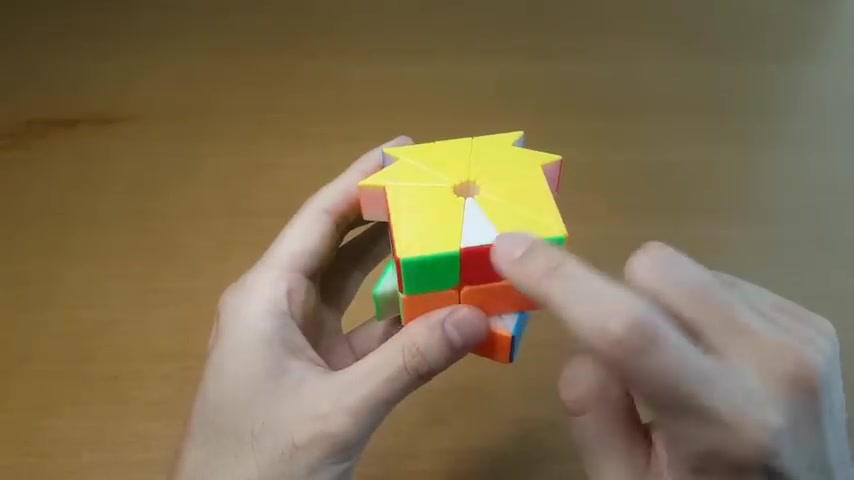
So algorithm and then there it is , and then we take the blue spot where that needs to go right here into the correct spot just right of the slice and then undo like that .
There we go .
Um Next , we need this yellow green to go to this spot .
Uh So the yellow green is on the left , this one's on the right and it's going to take the white piece out , which is annoying .
So we're just gonna take that white piece and put it into one of these two spots .
Let us do this one .
Um So now we'll put it over here .
Reverse .
OK ?
I think we're down to our last step .
Look at that , OK .
We have two pieces left to go and one unsolved up here , which is basically the same as what I show you on the three by three .
So if none of that made sense , at least this part should make sense .
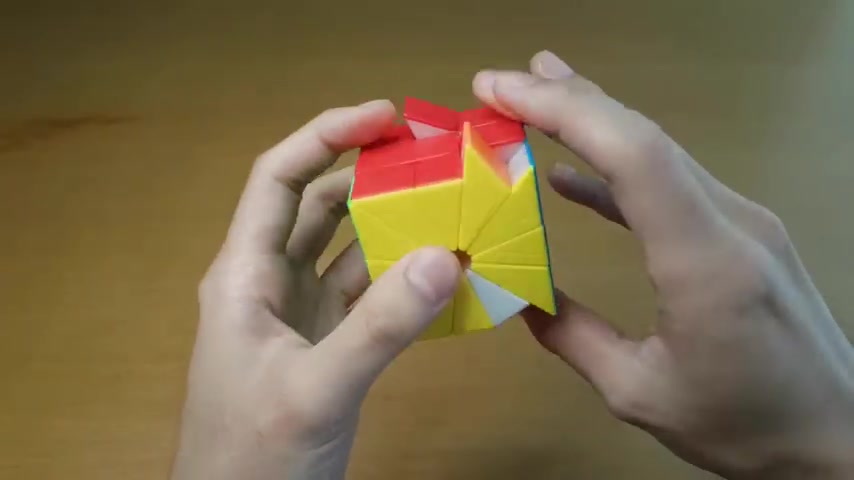
So we're gonna have this on the left side and we're gonna take the spot .
It needs to go right here and put that on the right side here .
OK .
So algorithm this plot over reverse , don't mess up , don't mess up .
Oh I did it .
I cannot believe how much easier this was compared to what I thought look , I did say at the beginning , it may be easier , maybe harder than a square one .
But this , I think because I can do commentators .
Oh I wish I could do commentators on every puzzle .
I literally try every puzzle if I can do a commentator but this one you actually can , which made it so much easier .
And that means I , I have to do a time solve on this .
Look , if I tried to do a time solve on a square one , it would take more than an hour .

I'm sure because I don't even think it would be that much faster than when I tried to figure it out for the first time .
But this is so much easier .
The square two is actually so much easier .
Uh scrambling is definitely still tough because I am not a square one solver .
So none of these finger tricks feel natural to me .
Actually , the reason I never practiced .
Square one was so that square two would feel very foreign me .
And by the way , I love the way that it looks when it's scrambled before we start this solve though .
I wanna say I've experienced almost the exact same thing before .
This is the puppet cube one and this is the puppet Cube two .
Puppet cube two was not that hard , but puppet Cube one was the hardest challenge of my life .
And I will not stop saying that I will not stop finding a way to talk about Puppet Cube in every single video because that is the only way to make that horrendous experience worth it .
Anyway , time to solve this thing .
Let's begin .
Um Let's get this one over here .
Move it up like that .
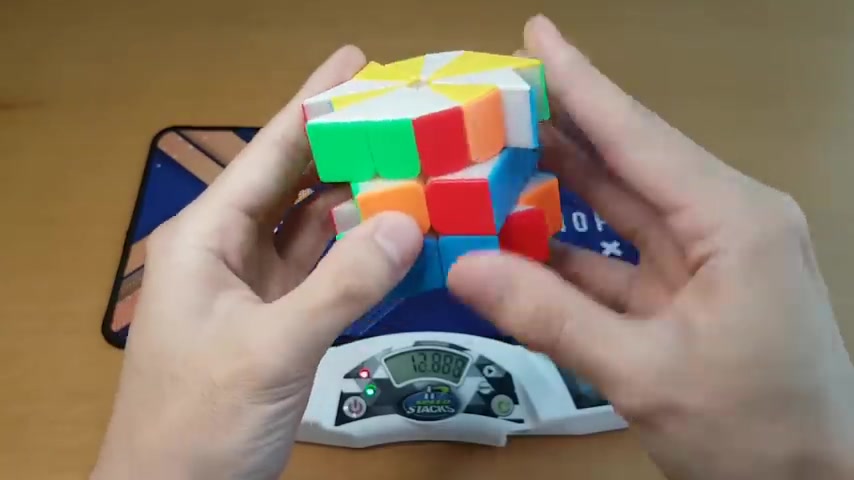
And then we have , oh I'm so bad at visualizing where things will be at the bottom .
So I keep having to do key rotations .
I need this corner piece and then uh the edge piece where to go .
It's over here .
Sorry for the Q rotations , square one solvers who go to my local competitions .
You guys are cringing right now .
OK ?
There's half of it and then I need to work on the other half which I'll do on the other side like that .
There we go and um look at that using the backside to solve this blue one .
What goes here ?
This would this would be orange .
Sorry , I'm losing my mind , right ?
Now , I actually , I actually don't have brain power anymore .
I tried so hard .
Oh , sweet .
But that's not correct .
I need this one on the other side .
Just move it very slowly .
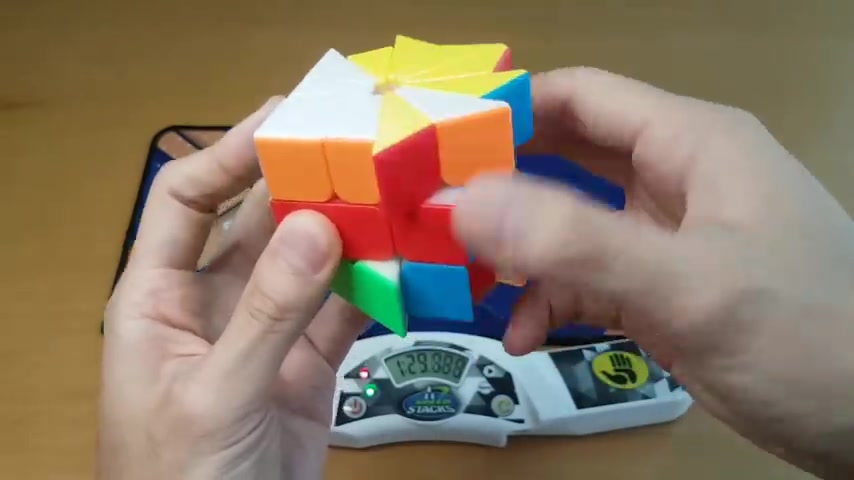
Watch the white piece on the right slowly inch its way over .
It's probably a faster way to do this .
Who cares ?
Let's put it all over here .
Let's turn this thing .
OK .
Turn to the other side .
I just realized I didn't need to solve all the white pieces .
But let's solve .
Uh let's solve this green edge .
So we move it over here .
Um So we take out this green edge with the algorithm and then move it so that the spot it needs to go is right here to the reverse algorithm .
And um the red corner goes here and the right edge goes here .
Somebody explain this to me .
I have parody .
Really parody is a thing on this .
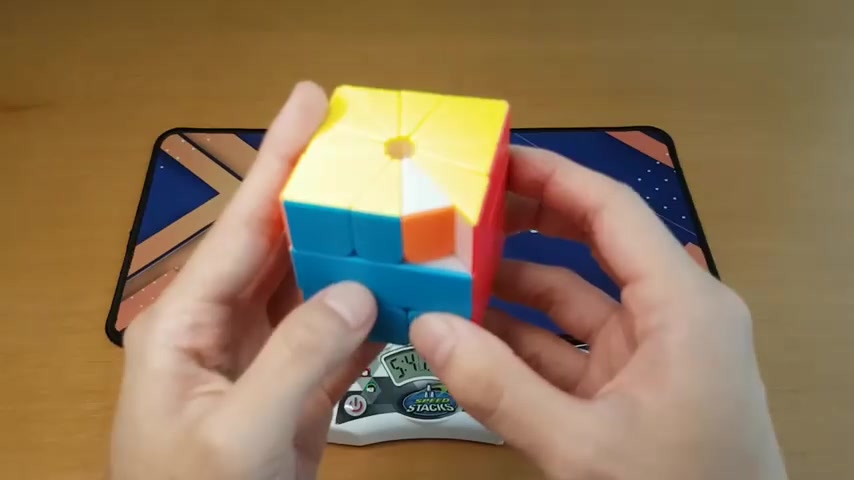
I'm so mad .
Well , this solve is a , is a rip but I think I know how I can fix this .
I know how I can do it .
So basically every piece needs to be shifted off by one .
That is so annoying , but I , I think this will fix parody .
That's so stupid .
OK ?
I think I can do this quickly though that on the bright side .
So that means this corner , if it's shifted by one , that means the corner needs to go here .
No , sorry .
Here where the edge already is So yeah , so we're gonna do this and then shift it by one and then undo so this is the reverse and then shift it by , by one again .
And I'm just gonna shift by one over and over and trust me , I think this should fix the parody issue .
Shift by one in reverse oh shift by one .
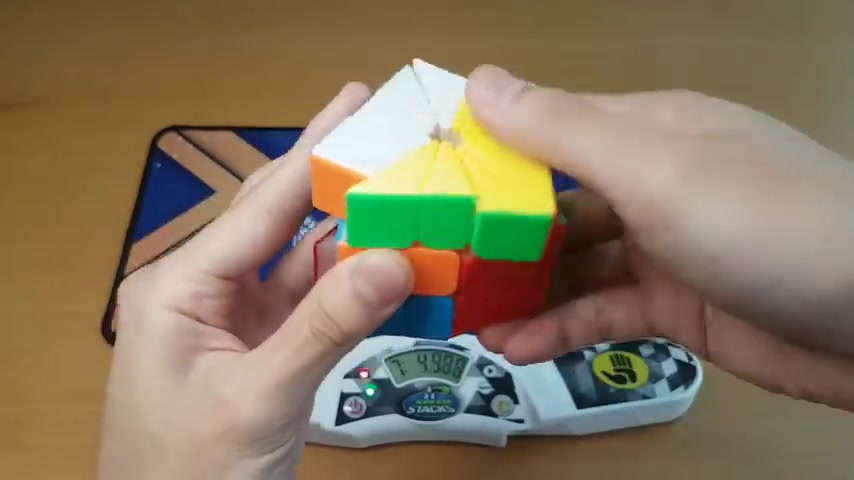
Oh This is so annoying and then by one and then reverse great commentary and then , OK , I'm losing my mind here guys .
This is , this is better work .
I'm glad my cube theory is actually coming into handy here because otherwise , like if it was many years ago , I would not even know what causes parody .
But now since I know what causes parody , I can roughly figure it out .
Yes .
Oh guys , that should have been like a four minute solve .
It took seven minutes because I ran into parody .
You think the square one parody , Alex is bad while you haven't tried square two ?
The youtuber in me wants every challenge to be as interesting and difficult as the puppet Cube .
But the laziness in me wants every new puzzle to end with commentators .
What a coincidence that square one and square two were both such fun puzzles to solve in this way .
And it is just a shame that I will never practice square one .
Are you looking for a way to reach a wider audience and get more views on your videos?
Our innovative video to text transcribing service can help you do just that.
We provide accurate transcriptions of your videos along with visual content that will help you attract new viewers and keep them engaged. Plus, our data analytics and ad campaign tools can help you monetize your content and maximize your revenue.
Let's partner up and take your video content to the next level!
Contact us today to learn more.